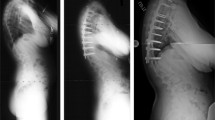Abstract
Study Design
Multicenter matched case analysis.
Objective
Compare patients with Lenke 5C scoliosis surgically treated with anterior spinal fusion with dual rod instrumentation and anterior column support versus posterior release and pedicle screw instrumentation.
Summary of Background Data
Treatment of single, structural, lumbar and thoracolumbar curves in patients with adolescent idiopathic scoliosis (AIS) has been the subject of some debate. Previous papers directly comparing these approaches are problematic because of heterogeneity of the groups, nonrandomized protocols, and surgeon bias and variation of instrumentation (upper instrumented vertebrae and lower instrumented vertebrae) in relation to the defined Cobb angle (upper end vertebra and lower end vertebrae). This report sought to remedy these flaws by analyzing a database of Lenke 5C AIS and performing matched cases.
Methods
We analyzed 96 patients with Lenke 5C AIS curves based on radiographic and clinical data at 3 institutions, surgically treated between 2001 and 2005 with minimum 2-year follow-up. Case matched criteria (age within 1 year, sex, curve within 5°, lower end vertebrae, and lower instrumented vertebrae) yielded 21 matched patient pairs. We evaluated and compared multiple clinical and radiographic parameters.
Results
We observed no significant statistical differences between groups in any preoperative clinical or radiographic parameters. At final follow-up, the major curve measured 8° (83%) in the posterior spinal fusion group, compared with 13° (72%) in the anterior spinal fusion group (p =.002). Estimated blood loss was similar in both groups. Hospital stay was significantly shorter in the posterior spinal fusion group. There were no differences in radiographic complications, such as proximal junctional kyphosis.
Conclusions
At a minimum of 2 years’ follow-up in a multicenter, matched case analysis, adolescents with Lenke 5C curves demonstrated statistically significantly better curve correction and shorter hospital stays when treated with a posterior release with pedicle screw instrumented fusion compared with an anterior instrumented fusion with dual rods for similar patient populations.
Similar content being viewed by others
References
Shufflebarger HL, Geek MJ, Clark CE. The posterior approach for lumbar and thoracolumbar adolescent idiopathic scoliosis: Posterior shortening and pedicle screws. Spine (Phila Pa 1976) 2004;29:269–76.
Geek MJ, Rinella A, Hawthorne D, et al. Comparison of surgical treatment in Lenke 5C adolescent idiopathic scoliosis: anterior dual rod versus posterior pedicle fixation surgery: A comparison of two practices. Spine (Phila Pa 1976) 2009;34:1942–51.
Hurford RKJ, Lenke LG, Lee SS, et al. Prospective radiographic and clinical outcomes of dual-rod instrumented anterior spinal fusion in adolescent idiopathic scoliosis: Comparison with single-rod constructs. Spine (Phila Pa 1976) 2006;31:2322–8.
Wang Y, Fei Q, Qiu G, et al. Anterior spinal fusion versus posterior spinal fusion for moderate lumbar/thoracolumbar adolescent idiopathic scoliosis: A prospective study. Spine (Phila Pa 1976) 2008;33:2166–72.
Halm H, Niemeyer T, Link T, et al. Segmental pedicle screw instrumentation in idiopathic thoracolumbar and lumbar scoliosis. Eur Spine J 2000;9:191–7.
Bernstein RM, Hall JE. Solid rod short segment anterior fusion in thoracolumbar scoliosis. J Pediatr Orthop B 1998;7:124–31.
Kaneda K, Shono Y, Satoh S, et al. New anterior instrumentation for the management of thoracolumbar and lumbar scoliosis: Application of the Kaneda two-rod system. Spine (Phila Pa 1976) 1996;21:1250–61. discussion 1261-2.
Lenke LG, Betz RR, Harms J, et al. Adolescent idiopathic scoliosis: A new classification to determine extent of spinal arthrodesis. J Bone Joint Surg Am 2001;83:1169–81.
Author information
Authors and Affiliations
Corresponding author
Rights and permissions
About this article
Cite this article
Geek, M.J., Rinella, A., Hawthorne, D. et al. Anterior Dual Rod Versus Posterior Pedicle Fixation Surgery for the Surgical Treatment in Lenke 5C Adolescent Idiopathic Scoliosis: A Multicenter, Matched Case Analysis of 42 Patients. Spine Deform 1, 217–222 (2013). https://doi.org/10.1016/j.jspd.2013.01.002
Received:
Revised:
Accepted:
Published:
Issue Date:
DOI: https://doi.org/10.1016/j.jspd.2013.01.002



